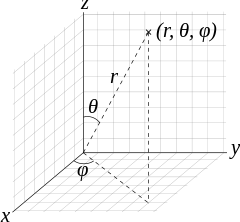In this article, we will calculate the Euclidian metric tensor for a surface of a sphere in spherical coordinates by two ways, as seen in the previous article Generalisation of the metric tensor
- - By deducing the metric directly from the space line element
- - By calculating the metric from the product of derivatives of the two-dimensional Cartesian coordinates system

Deducing the metric by the line element
In this Euclidian three-dimensionnal space, the line element is given by:
dl2 = dr2 + r2dθ2 + r2sin2θdΦ2
If we set the polar coordinate r to be some constant R we lose the dr term (because r is now constant) and the line element now becomes:
dl2 = R2dθ2 + R2sin2θdΦ2
which describes a two-dimensional surface using the two polar coordinates (θ, Φ)
Or we know from the previous article that this line element could be written as:
dl2 = gijdxidyj
We can deduce immediately that the metric and inverse metric for this surface, using coordinates x0=θ and x1=Φ, are:

This was the easy part. Let's try to calculate the same metric by using the formula of the coordinates derivatives product.
This section of the article is only available for our subscribers. Please click here to subscribe to a subscription plan to view this part of the article.

